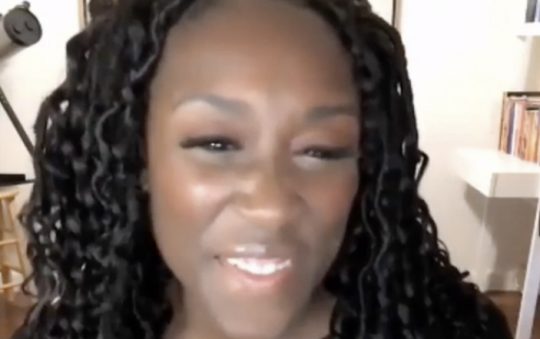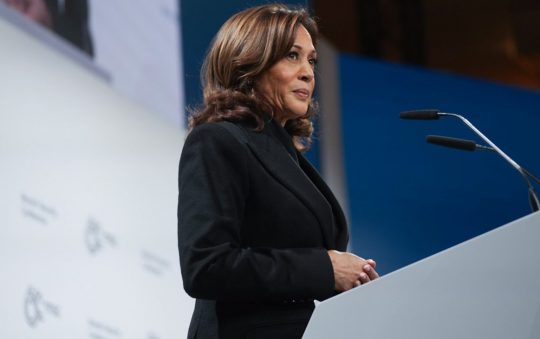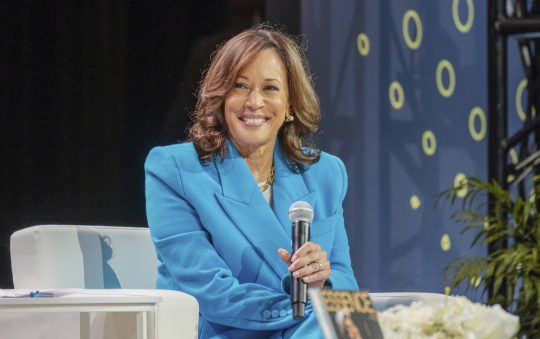
U.S. Senator Kamala D. Harris delivered remarks at the Justice Action Network’s “Women Unshackled” Conference, a bipartisan event held to address the drastic increase in the female prison population. During her remarks, Harris discussed the importance of reforming criminal justice policies that impact incarcerated women, focusing on prevention and the humane treatment of women during and after incarceration.
“This is such an important conversation and it does not ever receive the kind of attention it deserves, based just on the prevalence of it in terms of the number of people that are impacted,” Harris said. “And also, and I say this with a strong sense of optimism, that there is just so much that we can actually do to fix what is broken. And it’s not going to require us to be that creative. The solutions, some of them, are pretty obvious, and the more attention we give to the issue, I think, the more obvious they will be to a larger number of people.”
Recently, Harris joined Senate Democratic colleagues to introduce the Dignity for Incarcerated Women Act, which would make common-sense reforms to how incarcerated women are treated in federal prisons. Harris also recently visited the Central California Women’s Facility in Chowchilla, California, the largest women’s facility in the world.
Harris’ full remarks, as delivered:
Nicole, I just want to thank you for your extraordinary leadership, and I’m just so thankful to you, the Brennan Center, Google, everyone who’s a part of this.
This is such an important conversation and it does not ever receive the kind of attention it deserves, based just on the prevalence of it in terms of the number of people that are impacted. And also, and I say this with a strong sense of optimism, that there is just so much that we can actually do to fix what is broken. And it’s not going to require us to be that creative. The solutions, some of them, are pretty obvious, and the more attention we give to the issue, I think, the more obvious they will be to a larger number of people.
But I want to thank everyone here for the leadership and for the work and for the support around this issue of women and the need to unshackle women.
So good morning. Let’s just talk about this in this context. It is a critical and important issue. I have spent, as you heard in the introduction, my career in law enforcement. My parents were active in the Civil Rights Movement. My sister Maya and I joke we grew up surrounded by a bunch of adults who spent full time marching and shouting. But I decided I wanted to be a prosecutor, which many in my family thought was a curious decision. With some of them, I actually had to defend that decision like one would a thesis.
But what I said then, way back when, and what I say today after a career in law enforcement is that law enforcement has such a profound and direct impact on the most vulnerable among us. And has a responsibility, then, to be a voice for the most vulnerable and voiceless. And in the process of giving safety, there is also a responsibility to give dignity. So that is the lens through which I think of this issue, all that is part of my background and experiences.
In fact, after my second summer in law school, I clerked at the Alameda County District Attorney’s office that has the distinction of being one of the great DA’s offices in the country in large part because years before, Earl Warren led that office. And I remember distinctly – my mother used to talk about it years later – one day, it was a Friday, and I was in a court room and I started my career there during the height of the crack epidemic. So there had been a big drug bust, and there were a collection of cases that came in and in going through the cases, I realized that there was this person who had been swept up in the drug bust. That was a Friday afternoon. And I remember realizing when I was looking at the case that the case, of course, would not have been called until Monday. This person was an innocent bystander who had been swept up, and because it was late Friday afternoon, most people had gone home.
When I looked a little closer at the case, I realized that this person, this woman, had young children. And I realized that, of course, no one, if they are innocent, should be held in jail, and certainly not over the weekend. But for this person in particular, I realized also that it would mean that by not being able to go home, it is very possible that she could have lost her job. It is very possible that if her children were unsupervised, that Child Protective Services would come and pick them up. And all that would happen to her life if she had to stay in jail over the weekend.
And so as a young law student, I sat in that courtroom and I said we’ve gotta do something about it and I waited, and I waited, and I waited and the judge finally, getting a bit fed up with me, came out and with the swipe of a pen, made the decision to release that woman over the weekend.
Here’s the point of that story. In the criminal justice system, individuals have so much discretion. I, as a young twenty-something year old law student, could make a decision about someone’s liberty and life. The judge, of course, with the swipe of a pen, could make a decision about someone’s liberty and life. And so when we think about this issue, we must always keep in mind the power that individuals have who are participating in the system and by extension, those of us who have taken on roles of leadership around policy making and by extension, all of us as leaders in terms of our advocacy and the voice that we have that can play a role in addressing what might be wrong with these situations.
And so I think about this in that context, and when it comes, then, to this issue, I also think about it through the lens of this. For years, I’ve said that I think we’ve been offered a false choice on criminal justice policy. A choice that suggests one is either soft on crime or tough on crime instead of asking, as we smart on crime? And so I can tell you from my experience on this issue of incarcerated women, we need to be smarter. We need to be smarter, especially when it comes to the issues that impact this particular population.
For example, there are 215,000 women sitting in American jails and prisons right now. We need to be smarter.
Nearly one-third of all female prisoners in the world are right here in the United States. We need to be smarter.
And when the fastest-growing segment of our prison and jail population is women, we need to be smarter.
And the answer, by the way, is not to build more prisons.
And the answer is certainly not to privatize those prisons.
Wait, I’m not done, I’m not done. And the answer, Jeff Sessions, is not to return to relying on mandatory minimum sentencing.
We need to be smarter. We need to be smarter. And so let’s think about how we can, in being smarter, reevaluate what we are doing and think about how we are treating women in the system before, during, and after incarceration.
So let’s start with the facts.
First of all, and it has been said, Nicole mentioned it, I am a prosecutor in my bones. Somebody commits a serious and violent offense, there is no question they need to be held accountable and there must be severe, swift, and certain consequence.
That being said, we also know that right now, there are women in prison facilities, in jail facilities, that don’t support – those facilities don’t support basic hygiene or reproductive health. And that’s wrong.
Right now, there are incarcerated women subjected to the threat of sexual violence, when they are being supervised by male guards in the bathroom or shower. That’s wrong.
Right now, there are women who are shackled while they are pregnant and in some states, while they give birth. That’s wrong.
These are human costs to this system. And I’m proud, frankly, to cosponsor, along with Senator Cory Booker who I know is going to be here later, a dear friend, Senator Elizabeth Warren and Dick Durbin, a bill that we have named the Dignity for Incarcerated Women Act that will address some of these issues.
But the impact does not stop there. An incarcerated woman means that a family will be impacted. And its effects can be generational. What impacts a mother, impacts a child.
Because the fact is, on this subject we must keep in mind, nearly 80% of incarcerated women are mothers. Most, 65%, have children who are under 18 years old.
Half of the incarcerated women in our country are more than 100 miles away from their families. So let’s talk about what that means in terms of the ability to maintain the relationships with visitation and be clear about this, these prisons aren’t on the Acela line. They’re not on a commuter line, so it’s not easy to get there. These are real issues and we have to keep them in mind.
Let’s keep in mind that phone bills for a family can, during the life of the sentence, data shows us can be as much as $30,000 for that family. It’s just not right.
And research shows us that incarceration of a head of household can result in a two-third decline in the assets of that household. So there are real economic costs, in addition to the human cost, associated with this issue.
And let’s not even mention if either or both parents are in prison, what that means in terms of the likelihood that those children will end up in foster care. And as we know, there is a plethora of data about what that means for those children and what that means in terms of the odds being stacked against them.
So let’s understand the facts, everybody, and then let’s think about it in another context.
As a United States Senator, I agree that we must talk about wasteful spending in our country and by our government. I agree with that. I agree that we must be talking about the national debt. I agree and feel strongly we must be talking about tax reform. But let’s be clear, if you care about those things, then you must also care and pay attention to what we need to do to reform our criminal justice system.
These issues are connected. So, many people will hear this speech and others and they’ll think well, but this issue doesn’t impact me, I don’t know anybody in jail. I’ve never been to jail.
Oh, but it does. Oh, but it does.
It impacts you in terms of crimes that may be committed in your community. It impacts you in terms of wasteful drains on our public systems. It impacts you if you think of yourself as being a member of a civil society.
And so, here’s how I think we should then think about it going forward, and it’s about rethinking criminal justice policy and thinking about it in terms of, “OK then, so Kamala, fine, what should it look like?”, you say.
So here’s the thing. We all know from the public health model that one of the best, most effective, and cheapest ways to deal with an epidemic, health or crime, is prevention first.
So let’s talk about that in terms of the status of what we do before a woman has to be incarcerated. What do we do in terms of prevention?
You know, when I was DA of San Francisco, I focused on this in a number of ways, including I looked at the fact that twenty of our homicide victims who were under the age of twenty-five, 94% of them were high school dropouts. And then I realized an elementary school truant is three to four times likely to be a high school dropout.
And so I created this whole agenda and an initiative focused on elementary school truancy. And you all, half of you are going to boo because half of the city booed when I did what I did, but I said OK, this is a big issue, nobody is paying attention to it. I’m going to be the bad guy.
And I said, this is serious, this is real, and I’ve decided I’m going to start prosecuting parents for truancy. I’m telling you, half the city threw tomatoes at me, virtually not really.
And of course, I had no desire to prosecute those parents. But I said look, we have got to understand how serious this is because a child going without an education is tantamount to a crime.
So let’s, as a community, understand that we all should be invested in this issue. And we put in place initiatives and programs and we didn’t end up prosecuting that many parents at all. It was all about getting them resources and services that existed and that they needed, and we improved attendance rates by over 30%.
So prevention, and there are different ways to do it. I know a lot of you don’t agree with that effort but I will tell you that overall, it had a huge impact because we focused on prevention.
So think about it, then, in terms of who the women are who are incarcerated. And think about it in terms of dealing with seemingly small issues now because they become big issues.
So for example, a seemingly small issue for some people, cause they just don’t think about it, is untreated, undiagnosed, undetected trauma among our family members, among our neighbors, among our coworkers, among people who live in our community. And let’s be clear about this, undiagnosed, untreated trauma.
So let’s talk about trauma. That means you’ve been exposed to something really bad. It was harmful to you, it hurt you or it hurt somebody you know and love.
Eight out of ten women in the criminal justice system, the data tells us, have experienced some level of abuse. A large number have experienced abuse at the hands of someone who was in a position of trust, taking the form of child sexual abuse. A lot have faced abuse then and then later in life around domestic violence.
So let’s be clear about something on this issue of trauma. It means that you end up feeling pain beyond the pain of the incident that invoked the trauma.
Well, guess what? Normal human beings don’t like to feel pain. And so what ends up happening, we figure out ways to not feel that pain.
And for many of the women we are talking about, that involved self-medication. And that leads to, of course, substance abuse, drug addiction, alcoholism, and we see the cycles then start. And what those addictions cause those women to do and how vulnerable it makes them. They end up being vulnerable to predatory practices, people who take advantage of them.
You commit this crime and I’ll give you the drugs. You take the heat for what happened because otherwise people are going to judge you harshly anyway.
So let’s look at issues like prevention and recognize that on this subject of incarcerated women, a large issue, a very big issue, is what we need to do around addressing trauma and treating it in healthy ways. And giving these women options and accessibility to all that is available and can be available to help them with their trauma and help them with treatment.
Let’s look at the fact that there is an issue around how much we are paying, and again this gets back to the economic cost, it costs us about $33,000 a year to lock somebody up, in California it costs about $75,000 a year. Drug treatment on average is about $4,700. So it just makes economic sense in addition to what it means in terms of dealing with prevention. It only costs $10,000 for community mental health services.
So if we, like our friends in the private sector, are judging ourselves in government, unburdened by ideology, then this information forces us to understand that the best way to judge ourselves is to ask the question our friends in the private sector as every day. What is the, and they use three letters, what is the ROI? What is the return on the investment? Cause guys, as tax payers, we’re not getting a good return on our investment on this issue.
So let’s think about it from that perspective.
Let’s think about it from the perspective of, you know, when I was home last week, or the week before, I visited with the women in the Chowchilla state prison. It’s in Chowchilla, California, it is said to be the largest facility for women in the world. And I was there cause I just wanted to spend some time with the folks that are there and talk with them about current conditions and what’s going on. In fact, all the women I met with I told them that I was going to come back and talk about them with you guys. I said I’m going to be talking about you behind your back but I have good things to say.
And these women were extraordinary, and their stories were the stories that you will be hearing throughout the session today. You know who they are, you will know who they are.
But I have to tell you, one of the things that I found to be unexpected, is that so many of these women now in this facility, which is not perfect but they’ve engaged in some innovative practices around mental health treatment and group therapy and training and giving people apprenticeships and teaching them to be electricians and all of that, is that these women, sitting with them, many of whom had actually committed serious and violent offences, having gone through these innovative programs, had an incredible amount of optimism about themselves and their lives and what they would be when they got out. And I found that encouraging because it also is about understanding something that is an age-old concept that really transcends every religion. And it’s the concept of redemption.
So, redemption. At the heart of that point is this. We will all make a mistake, and for some of us that mistake will rise to the level of being a crime. And yes, there must be accountability and consequence. But is it not the sign of a civil society that we allow people the space and the ability and the resources to earn their way back?
So I’ll close with this. You know, one of the areas in the prison that I visited was, they were doing silk screening because they were actually producing – we all, almost every day, put our hand over our heart and pledge allegiance to the flag of the United States of America. You know, you look out that window, you see the Capitol. Flags wave there all the time. Well, at Chowchilla, a lot of those flags are actually being made by those women.
So I walked into a room almost as big as this one and there they were doing everything from cutting the fabric to doing the silk screen and pushing the paint right through the stars and through the stripes. And there was something about the symmetry, some symmetry there in my mind that I walked away thinking about which is, isn’t it part of who we are as Americans that we believe in second chances?
And as we think about, not only before and during but after, shouldn’t we, if we are truly going to do what we can do with this population in the spirit of who we are as a country, understand that it is incumbent upon us to also appreciate that concept of what needs to happen around second chances and redemption?
So that’s how I think about this issue and I’m going to close my comments now so we can have a conversation and maybe talk about some of the other things we can do specifically.
Thank you all.







